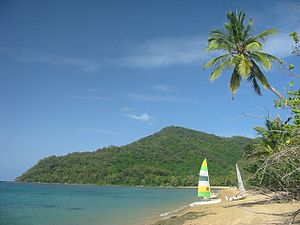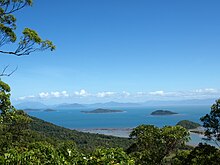Dunk Island
| Dunk Island | ||
|---|---|---|
| Brammo Bay with Mount Kataloo in the background | ||
| Waters | Pacific | |
| Geographical location | 17 ° 56 '33 " S , 146 ° 9' 20" E | |
|
|
||
| length | 5.75 km | |
| width | 2.05 km | |
| surface | 9.7 km² | |
| Highest elevation |
Mount Kootaloo 271 m |
|
Dunk Island is a small island of Australia , located in the northwest in the state of Queensland 4.5 km off the coast of Mission Beach . The island is 6 km long and 2 km wide. She belongs to the Family Islands group . The largest part of the island (730 ha) consists of a national park and a small runway for airplanes, the rest (240 ha) is shared by a resort and farmland in the northwest. The reef surrounding the island is part of the Great Barrier Reef National Park.
Dunk Island is by far the largest island in the Family Islands National Park, all of which are made up of granite rocks. All islands were part of the mainland before sea levels rose 8000 years ago. The topography varies, with sandy beaches and rocky coasts, slightly hilly slopes, but also steep terrain. The highest point on the island is Mount Kootaloo (271 m). Other islands of the Family Islands can be seen from the viewing platform on its summit. Part of the tropical rainforest and smaller beaches (e.g. Muggy Muggy and Coconut Beach) can be reached via the island's 13 km long hiking trails.
There are over 100 species of birds on Dunk Island, including rare and endangered sea birds. During the summer months the island becomes a breeding ground for terns. The lack of predators, along with an abundant supply of food from the surrounding waters, make them an ideal breeding site. Among other things, it is part of the range of the Victoria bird of paradise . Dunk Island is also home to reptiles such as pythons, tree snakes, monitor lizards, geckos, and lizards. The reefs surrounding the island and the surrounding waters are home to a wide variety of marine life such as turtles, dugongs , corals, fish, clams, and crabs.
history
The original owners of Dunk Island are the Bandjin and Djiru Aboriginal tribes who lived in the area for more than ten thousand years. After the sea level rose, they used the island to collect food and materials. The Aboriginal name for Dunk Island is Coonanglebah , or "The Island of Peace and Abundance". The island got its English name from James Cook , who sailed past it on June 8, 1770 and named it after George Montague-Dunk , the 2nd Earl of Halifax.
The first resident from the western world was Edmund James Banfield , who lived on the island between 1897 and 1923 and examined its flora and fauna , among other things . Banfield became famous in 1908 for his novel The Confessions of a Beachcomber , which he wrote on Dunk Island. He and his wife are buried on the island.
The island was bought by Captain Brassey in 1934. Banfield's bungalows formed the basis for the start of today's portfolio. The Royal Australian Air Force occupied the island during World War II and built the runway in 1941. They set up a radar station on the highest point of the island a year later, which was dismantled after the war. The Brassey family sold Dunk Island to Eric McElree of Avis Rent-A-Car in 1956, who expanded the resort's facilities. In 1976, Trans Australia Airlines finally bought Dunk Island. After the TAA merged with Qantas Airways , the island became their property in 1992. On December 24, 1997, the island was acquired by P&O, which in turn was bought in 2004 by the current owner, Voyages .
The maximum temperatures on Dunk Island are between 25 ° C in July and 32 ° C in December and January.
You can get to the island either by plane or by ferry from Mission Beach .
Web links
- Article about Dunk Island from the Australian newspaper Sydney Morning Herald
Individual evidence
- ↑ PJ Higgins, JM Peter and SJ Cowling: Handbook of Australian, New Zealand & Antarctic Birds: Volume 7 Boatbill to Starlings, Part A: Boatbill to Larks . Oxford University Press, Melbourne 2006, ISBN 978-0-195-55884-5 . P. 644


